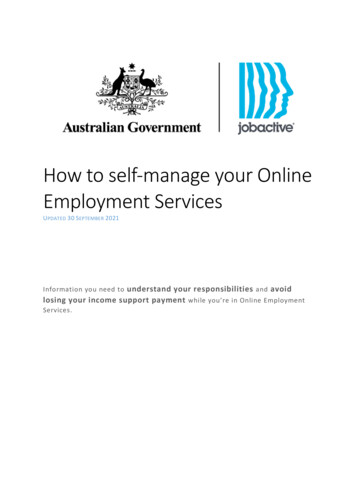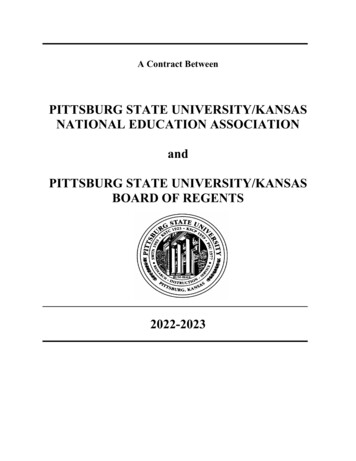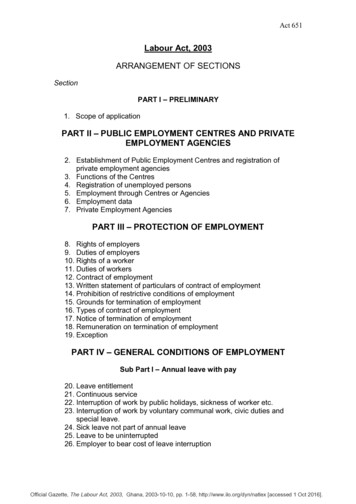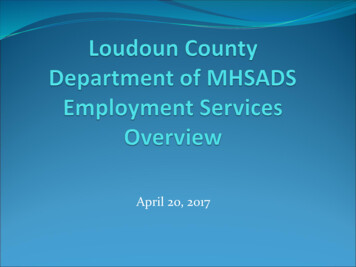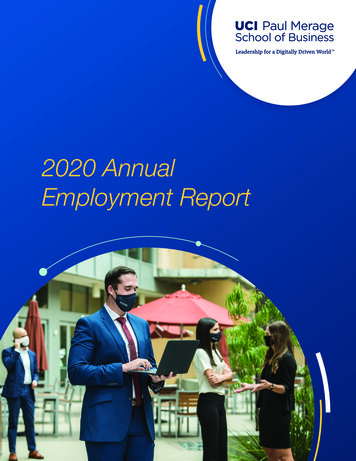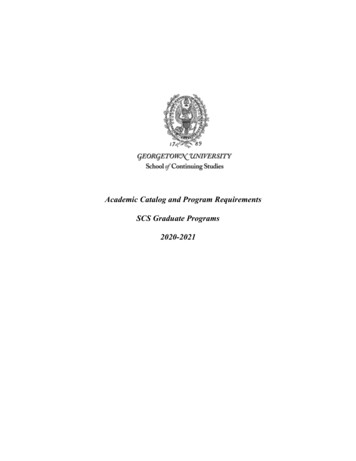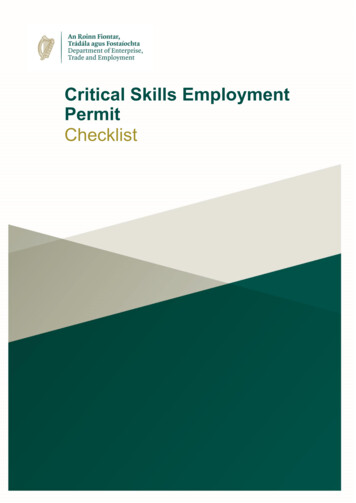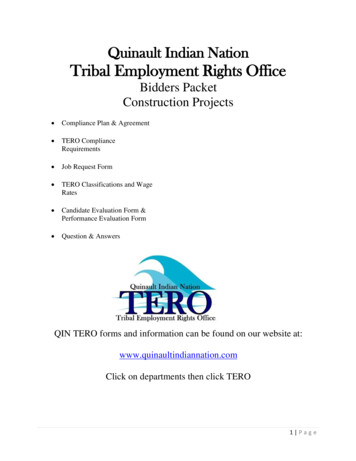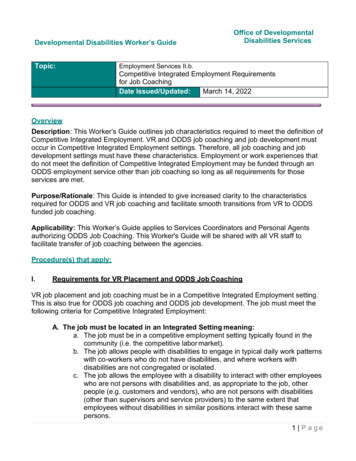
Transcription
Developmental Disabilities Worker’s GuideTopic:Office of DevelopmentalDisabilities ServicesEmployment Services II.b.Competitive Integrated Employment Requirementsfor Job CoachingDate Issued/Updated:March 14, 2022OverviewDescription: This Worker’s Guide outlines job characteristics required to meet the definition ofCompetitive Integrated Employment. VR and ODDS job coaching and job development mustoccur in Competitive Integrated Employment settings. Therefore, all job coaching and jobdevelopment settings must have these characteristics. Employment or work experiences thatdo not meet the definition of Competitive Integrated Employment may be funded through anODDS employment service other than job coaching so long as all requirements for thoseservices are met.Purpose/Rationale: This Guide is intended to give increased clarity to the characteristicsrequired for ODDS and VR job coaching and facilitate smooth transitions from VR to ODDSfunded job coaching.Applicability: This Worker’s Guide applies to Services Coordinators and Personal Agentsauthorizing ODDS Job Coaching. This Worker's Guide will be shared with all VR staff tofacilitate transfer of job coaching between the agencies.Procedure(s) that apply:I.Requirements for VR Placement and ODDS Job CoachingVR job placement and job coaching must be in a Competitive Integrated Employment setting.This is also true for ODDS job coaching and ODDS job development. The job must meet thefollowing criteria for Competitive Integrated Employment:A. The job must be located in an Integrated Setting meaning:a. The job must be in a competitive employment setting typically found in thecommunity (i.e. the competitive labor market).b. The job allows people with disabilities to engage in typical daily work patternswith co-workers who do not have disabilities, and where workers withdisabilities are not congregated or isolated.c. The job allows the employee with a disability to interact with other employeeswho are not persons with disabilities and, as appropriate to the job, otherpeople (e.g. customers and vendors), who are not persons with disabilities(other than supervisors and service providers) to the same extent thatemployees without disabilities in similar positions interact with these samepersons.1 P a ge
i. This interaction must occur as part of the individual’s performance ofwork duties and must occur both in the particular work unit and theentire work site, as applicable. In other words, individuals withdisabilities must have the opportunity to interact with non-disabled coworkers during the course of performing work duties to the sameextent that that their co-workers who do not have disabilities interactwith each other when performing the same work.ii. “Other persons”, as defined in the Workforce Innovation OpportunityAct, means other employees without disabilities with whom theemployee with the disability works within the specific work unit andfrom across the entire work site.iii. The interaction of primary consideration should be that between theemployee with the disability and his or her colleagues or coworkerswithout disabilities in similar positions. The interaction must be forpurposes of performing job duties, and not casual, conversational, andsocial interaction that takes place in the workplace.iv. Individuals working under contracts that mandate a ratio of workerswith disabilities is not competitive integrated employment (e.g. workunder a federal AbilityOne contract or an Oregon QRF contract).See list .pdfv.Individuals with disabilities hired by community rehabilitation programs(CRPs) to perform work under service contracts, either alone or ingroups (e.g. landscaping or janitorial crews), whose interaction withpersons without disabilities (other than their supervisors and serviceproviders) is with persons working in or visiting the work locations andnot with employees of the CRP without disabilities in similar positions,would not be performing work in a competitive integrated setting. Anexample of when this work would not be considered competitiveintegrated employment includes when a provider holds a contract andhires multiple people with disabilities to perform the contract worktogether.These programs, if provided in a community setting and paid atminimum wage or higher are typically considered Supported SmallGroup, and do not meet the requirements of Competitive IntegratedEmployment or individual integrated employment which is fundedthrough ODDS as job coaching.d. Settings or facilities established by community rehabilitation programsspecifically for the purpose of employing individuals with disabilities (e.g.sheltered workshops) do not constitute integrated settings because thesesettings are not typically found in the competitive labor market. CRPs aredefined to include organizations that provide job development, job coaching,and other employment services.2 P a ge
B. Competitive earnings and level of benefits:a. The person earns at least the minimum wage established by federal orapplicable state or local law (whichever is higher).b. The person earns not less than the customary rate paid by the employer forthe same or similar work performed by employees without disabilities andwho are similarly situated in similar occupations by the same employer andwho have similar training, experience, and skills.c. The person is eligible for the level of benefits provided to employees withoutdisabilities in similar positions. This consideration should take into account thetraining, experience, and level of skills possessed by the employees withoutdisabilities in similar positions.d. In the case of a person who is self-employed, the person must receive anincome that is comparable to the income received by other individuals whoare not individuals with disabilities who are self-employed in similaroccupations or doing similar work. This consideration should take intoaccount the training, experience, and skills of the self-employed personcompared to other individuals without disabilities.C. Opportunities for advancement:a. The employee with the disability must have the same opportunities foradvancement as employees without disabilities in similar positions.II.Examples:A. Work at a provider site or Community Rehabilitation Program (CRP) Designedto Hire People who have DisabilitiesA CRP designed to hire people who have disabilities typically does not meet the definition ofCompetitive Integrated Employment because, as outlined above, these programs and worksettings are not typically found in the competitive labor market and do not permit employees tointeract with other people who are not individuals with disabilities (excluding supervisors andservice providers) to the same extent that a person would interact with other persons in thesame or similar settings.Work at a provider site to complete contracts requiring a set ratio of people with disabilities, ora certain number of work hours completed by people who have disabilities, is not CompetitiveIntegrated Employment, because the work takes place in a setting or program designed to hirepeople who have disabilities.If VR determines that the criteria regarding Competitive Integrated Employment have beensatisfied, and pays for the placement and initial job coaching, then transition to ODDS servicesmay occur at stabilization, and ODDS may generally fund any additional job coaching servicesthat are needed.ODDS presumes that a job at a provider site is Employment Path. However, if additionalinformation demonstrates the position meets the definition of Competitive IntegratedEmployment, then the support service may be job coaching. Providers need to submit3 P a ge
additional information to ODDS to overcome this presumption.The provider should complete the assessment found at the link below as soon as it becomesapparent that a person may consider taking a job at a provider site in order to streamlinetransition from VR to ODDS job coaching services.Information related to the assessment process for employment services at a provider sitecan be found here: Pages/provider-site-assessment-resources.aspxB. Crews / EnclavesCrews and enclaves generally are funded as Small Group Supported Employment. Asoutlined above, individuals with disabilities hired by CRPs or provider organizations toperform work under service contracts, either alone or in groups, whose interactions withpersons without disabilities are with persons working in or visiting the work locations or withtheir supervisors and service providers, and not with employees of the communityrehabilitation programs without disabilities, in similar positions, would not be competitiveintegrated employment.Work under a contract that mandates a ratio of workers with disabilities is not competitiveintegrated employment (e.g. work under a federal AbilityOne contract or Oregon QRFcontracts.See list here: . Seasonal or Temporary WorkVR guidance outlines the circumstances under which VR will fund services for temporary orseasonal work. See the following VR all-03-16-2018.pdfIf VR is unable to pay for job coaching in a setting that otherwise meets wage, benefits, andintegration criteria related to Competitive Integrated Employment (e.g. it is unclear if thetemporary or seasonal work will continue in the next recurring period), then ODDS will fundsupport for seasonal or temporary work as initial job coaching for the first season. Subsequentseasons would be funded as ongoing job coaching, maintenance job coaching, or attendantcare, depending on the amount of time the person has used job coaching and the amount ofjob coaching required (see Worker’s Guide regarding Job Coaching Requirements for moredetails).Form(s) that apply: CIE Checklist and VR Toolkit (see ODDS I/DD Employment Policy LOYMENT-FIRST/Pages/policy.aspx List of AbilityOne and Qualified Rehabilitation Facilities (QRF) providers in Oregon (i.e.not CIE).4 P a ge
See a list of Oregon QRFS and AbilityOne contracts maintained .pdfSee also the Federal AbilityOne Contract list (maintained by the AbilityOne program andnot ODDS or VR); and the Oregon QRF Contract list (maintained by the QRF programand not ODDS or VR).Definition(s):Workforce Innovation and Opportunities Act (WIOA), final rules -- are the rules Issued by theDepartment of Education (the Department) that govern the State Vocational RehabilitationServices program and the State Supported Employment Services program that have beenupdated, clarified and approved; and issued new regulations regarding limitations on the useof subminimum wage that are under the purview of the Department. (WIOA enacted on7/22/14; final rules released on 6/30/16, published on 7/30/16)(ED-2015-OSERS-0001).Reference(s):ODDS Assessment for Employment Services at Provider xODDS I/DD Employment Policy OYMENT-FIRST/Pages/policy.aspxWIOA final rules: s/list/osers/rsa/wioa-vr-final-rule.pdfWorkforce Innovation and Opportunities Act (WIOA) (Pub.L. 113-128; 07/22/2014); 34 CFR 361,363, and 397.Frequently Asked Questions:Contact(s):Regional Employment ent-Specialists.pdf5 P a ge
Competitive Integrated Employment Requirements for Job Coaching Date Issued/Updated: March 14, 2022 Overview Description: This Worker's Guide outlines job characteristics required to meet the definition of Competitive Integrated Employment. VR and ODDS job coaching and job development must occur in Competitive Integrated Employment settings.
![05[2] Strategy competitors, competitive rivalry .](/img/2/052-strategy-competitors-competitive-rivalry-competitive-behavior-and-competitive-dynamics.jpg)
